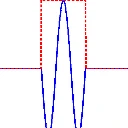Tags: Heaviside function / Complex integration / Spectrum
The Heaviside step function is very important in physics. It often models a sudden switch-on phenomenon and is therefore present in a lot of integrals. For example, the derivation of the Kramers-Kronig Relations can be significantly simplified once we know the Fourier-Transform \(\bar{\theta}(\omega)\) of the Heaviside function \(\theta(t)\). Although the function appears to be quite simple, the calculation of its Fourier transform can be quite challenging. Let's find out!
Problem Statement
Show that the Fourier transform is given by the following expression:
\[2\pi\bar{\theta}(\omega)=\int\limits _{-\infty}^{\infty}\theta(t)e^{i\omega t}dt=P\frac{i}{\omega}+\pi\delta(\omega),\]
where \(\delta(\omega)\) is the Dirac delta distribution and the functional \(P\) refers to the Cauchy Principal value.
Hint
- We can express the Heaviside function as: \(\lim_{\varepsilon\rightarrow0}\frac{1}{2\pi}\int\limits _{-\infty}^{\infty}\frac{i}{\omega+i\varepsilon}e^{-i\omega t}d\omega=\theta(t)\)
Solution
In order to prove the relation above we perform the inverse Fourier transform:
\[\frac{1}{2\pi}\int\limits _{-\infty}^{\infty}2\pi\bar{\theta}(\omega)e^{-i\omega t}d\omega=\frac{1}{2\pi}\int\limits _{-\infty}^{\infty}\left(\int\limits _{-\infty}^{\infty}\theta(t')e^{i\omega t'}dt'\right)e^{-i\omega t}d\omega=\theta(t).\]
Therefore, on the one hand we must show that:
\[\lim_{\varepsilon\rightarrow0}\frac{1}{2\pi}\int\limits _{-\infty}^{\infty}\frac{i}{\omega+i\varepsilon}e^{-i\omega t}d\omega=\theta(t),\]
where \(\lim_{\varepsilon\rightarrow0}\frac{i}{\omega+i\varepsilon}\) is an expression for \(2\pi\bar{\theta}(\omega)\) and on the other hand we also need to prove:
\[\frac{1}{2\pi}\int\limits _{-\infty}^{\infty}\left(\frac{i}{\omega}+\pi\delta(\omega)\right)e^{-i\omega t}d\omega=\theta(t).\]
1. Proving \(\lim_{\varepsilon\rightarrow0}\frac{1}{2\pi}\int\limits _{-\infty}^{\infty}\frac{i}{\omega+i\varepsilon}e^{-i\omega t}d\omega=\theta(t)\):
As we see the integrand has a pole at \(\omega=-i\varepsilon\), which is in the negative complex plane. Solving the integral we need to consider two cases, where the contour is a closed semicircle in the complex plane:
- Integral in the upper complexe plane \((t<0)\):
Here we obtain upon splitting the integral into its components:
\begin{eqnarray*}\int\limits _{-\infty}^{\infty}\frac{i}{\omega+i\varepsilon}e^{-i\omega t}d\omega&=&\mathcal{P}\int\limits _{-\infty}^{\infty}\frac{i}{\omega+i\varepsilon}e^{-i\omega t}d\omega+\int_{C_{2}}\frac{i}{\omega''+i\varepsilon}e^{\omega''t}d\omega\\&=&\mathcal{P}\int\limits _{-\infty}^{\infty}\frac{i}{\omega+i\varepsilon}e^{i\omega|t|}d\omega+\int_{C_{2}}\frac{i}{\omega''+i\varepsilon}e^{-\omega''|t|}d\omega=0,\end{eqnarray*}
because there are no poles in the upper complex plane and the integral along \(C_{2}\) vanishes for \(\omega^{\prime\prime}\longrightarrow\infty\). - Integral in the lower complexe plane \((t>0)\):
Using residue theorem the solution is:
\[\lim_{\varepsilon\rightarrow0}\frac{1}{2\pi}\left(\int\limits _{-\infty}^{\infty}\frac{i}{\omega+i\varepsilon}e^{-i\omega t}d\omega\right)=-\lim_{\varepsilon\rightarrow0}\frac{1}{2\pi}\left(2\pi i\,\textrm{Res}\left(\frac{i}{\omega+i\varepsilon}e^{-i\omega t};-i\varepsilon\right)\right)=1.\]
Therefore we get:
\[\Theta\left(t\right)=\lim_{\varepsilon\rightarrow0}\int\limits _{-\infty}^{\infty}\frac{i}{\omega+i\varepsilon}e^{-i\omega t}d\omega=\begin{cases}
1 & t>0\\
0 & else
\end{cases}\]
2. Proving \(\frac{1}{2\pi}\int\limits _{-\infty}^{\infty}\left(\frac{i}{\omega}+\pi\delta(\omega)\right)e^{-i\omega t}d\omega=\theta(t)\):
The first step is easy:
\[\frac{1}{2\pi}\int\limits _{-\infty}^{\infty}\left(\frac{i}{\omega}+\pi\delta(\omega)\right)e^{-i\omega t}d\omega=\frac{1}{2}-\frac{1}{2\pi i}\int\limits _{-\infty}^{\infty}\frac{1}{\omega}e^{-i\omega t}d\omega.\]
Now we will rearrange the second integral, obtaining:
\[\int\limits _{-\infty}^{\infty}\frac{1}{\omega}e^{-i\omega t}d\omega=\int\limits _{-\infty}^{0}\frac{1}{\omega}e^{-i\omega t}d\omega+\int\limits _{0}^{\infty}\frac{1}{\omega}e^{-i\omega t}d\omega.\]
In order to solve this integral we will consider a contour integral in the complex plane with a small semicircle around \(\omega=0\), where we obtain:
\[0=\oint\frac{e^{-i\omega t}}{\omega}d\omega=\int\limits _{-\infty}^{-0}\frac{e^{-i\omega t}}{\omega}d\omega+\int\limits _{+0}^{\infty}\frac{e^{-i\omega t}}{\omega}d\omega+\int\limits _{\pi}^{0}\frac{e^{-i\omega t}}{\omega}d\omega+\int_{C_{2}}\frac{e^{-\omega''|t|}}{\omega''}d\omega''\]
Since we just look at the case \(t<0\) the \(C_{2}\)-integral vanishes, as shown above. Using the parametrization \(\omega=\rho e^{i\phi}\quad\rightarrow\quad d\omega=i\rho e^{i\phi}d\phi\) we obtain:
\[\int\limits _{\pi}^{0}\frac{e^{-i\omega t}}{\omega}d\omega=\int\limits _{\pi}^{0}\frac{i\rho e^{i\phi}}{\rho e^{i\phi}}e^{-i\omega t}d\phi=-i\pi.\]
Also we get depending on the signum of \(t\), i.e. direction of the integration:
\[\int\limits _{-\infty}^{-0}\frac{e^{-i\omega t}}{\omega}d\omega+\int\limits _{+0}^{\infty}\frac{e^{-i\omega t}}{\omega}d\omega=-i\pi\cdot\textrm{sign}(t).\]
This leads to:
\[\frac{1}{2\pi}\int\limits _{-\infty}^{\infty}\left(\frac{i}{\omega}+\pi\delta(\omega)\right)e^{-i\omega t}d\omega=\frac{1}{2}\left[1+\textrm{sign}(t)\right]=\theta(t).\]
Quod erat demonstrandum. We have found the Fourier transformation of the Heaviside function!








